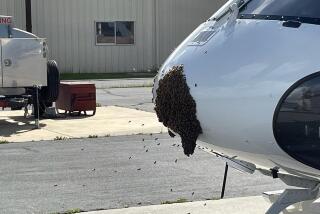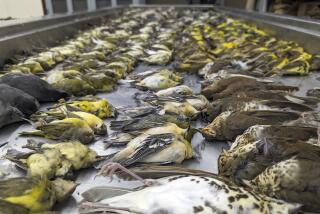Pilots Hope to Aid Cranes’ Migration
- Share via
WASHINGTON — Relying on a plan that inspired a Hollywood movie, the U.S. Fish and Wildlife Service hopes to reestablish a migratory flock of whooping cranes that would summer in Wisconsin and winter in Florida.
Ten to 25 cranes bred this spring in Maryland are to follow several ultralight aircraft and a Cessna 182 plane along a 1,250-mile migration route to central Florida next fall.
There are 400 whooping cranes in the world. But only one wild migratory flock, with 176 birds, now remains in North America, and it is endangered by petrochemical plants and barge traffic along the Gulf Coast of Texas.
The project unveiled Friday represents the culmination of 60 years of efforts to reestablish the whooping crane, at 5 feet the tallest bird in North America.
A century ago, flocks of the stately but temperamental cranes, which can live up to 25 years, made the annual round-trip flights between Wisconsin and Florida, but they succumbed to hunters and to a loss of nesting areas to farmers. The last recorded migratory flock was in 1911.
Chicks chosen for the flight next fall will be raised in isolation from humans but conditioned to the loud buzz of the small engines that power the Erector set-like, open-cockpit aircraft.
“They come to believe that the ultralight aircraft are their parents and they become part of the flock,” said Fish and Wildlife spokeswoman Joan Guilfoyle.
In 1994, Canadian pilots Bill Lishman and Joe Duff began a nonprofit group, Operation Migration Inc., to teach abandoned and endangered birds safe migratory routes. The 1996 movie “Fly Away Home” was based on their experience.
“It’s an incredible feeling; you’re very close to these birds,” said Duff, who last fall helped lead a flock of teenage sandhill cranes from Wisconsin to Florida. While 11 of 13 birds survived the trip, efforts to get sandhills and whooping cranes to mate have failed.
“A lot of emotions run through it,” said Duff, who dons a gray robe-like costume with a cloth-covered helmet for the flight. “It’s an amazing responsibility.”
The chicks are to be transported from the U.S. Geological Survey’s Patuxent Wildlife Research Center in Maryland to the Necedah National Wildlife Refuge in Wisconsin in late June. They will undergo about 30 hours of training with the small planes before their big adventure.
In early October, they are to start winging toward Chassahowitzka Wildlife Refuge in central Florida, pausing at more than 30 rest areas along the way.
Biologists believe that by the following spring the cranes’ instincts will prompt them to return to Wisconsin without coaxing. Over the next decade, the Fish and Wildlife Service hopes to establish 25 nesting pairs of cranes that will learn to make the annual migration without the guides.
Just 264 whooping cranes now remain in the wild, including the migratory flock that breeds in the Northwest Territories and adjacent areas of Alberta, Canada, and winters at the Arkansas National Wildlife Refuge in Texas.
The $1.3-million project, roughly half of the money from private fund-raising, requires approval from wildlife agencies and the cooperation of private landowners in 20 states.
More to Read
Sign up for Essential California
The most important California stories and recommendations in your inbox every morning.
You may occasionally receive promotional content from the Los Angeles Times.













